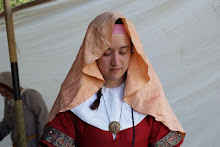So without further ado, the recipes:
From Petrus de S. Audemar (13-14th century):
"Of Certain Kinds of Gum or Glue: If you have not the air-bladder of a sea-fish, cut up thick vellum in the same manner, and wash it. Also wash carefully three times in warm water the dried bones of the head of a pike, and boil them. Whichever of these you boil, add to them one-third part of very clear gum, that is, gum arabic, and boil a little; and you may keep this as long as you will"
"How Glue is Made from Cheese: Fresh cheese is first to be washed in hot water, until the milk is washed out, and then ground with lime and water, in a little mortar or on a marble slab; and a little before this is done--namely, while the cheese is being ground--the colour is soaked in water again. Then, when the cement is prepared, so as to be as white, clear, and shining as milk, it is put into a small vase, and the colour is scraped into it with a kife, and care must be taken not to let the air have access to the mixture; and when the colour is seen to be good, it may be used for writing at pleasure."
Source: de S. Audemar, Petrus. "De Coloribus Faciendis". From Mrs. Mary P. Merrifeld. "Medieval and Renaissance Treatises on the Arts of Painting, Original Texts with English Translations". Dover Publications Inc., New York. 1967.
From the Marciana Manuscript (16th Century):
"A Most Excellent Glue for Damp and Moist Places which always becomes Harder, but only Fears the Heat, and Fixes Everything to Wood and Stone, which must be as Smooth as Porphyry: Take one pound of good yellow wax, nine ounces of liquid varnish, and one pound of black naval pitch. Put the varnish into a pipkin over a slow fire, that is hot enough to liquefy without burning it; then throw in the wax, liquefy it in the same manner and incorporate it well with the varnish; then do the same with the pitch, having previously pounded it, etc. Then take Armenian bole ground to a fine powder, and stir some of it into the other ingredients until the whole material becomes liquid, and yet so tenacious that it fixes and holds together firmly the things which you wish to glue together; and you must stir the ingredients well together and use them warm, because in a short time the cement hardens so that xou cannot glue with it. And when you have applied it where you please, and wish to make the surface smooth and polished, take a firebrand from the fire and bring it near to the glue until the heat causes it to liquefy and spread; you should also move about the firebrand over the surface of the glue, and melt it so that it at length becomes smooth and beautiful &c. And on putting the work which you have cemented into water, it will immediately become very hard."
Source: Divers Secrets (Extracts from a manuscript in the Marciana Library at Venice). From Mrs. Mary P. Merrifeld. "Medieval and Renaissance Treatises on the Arts of Painting, Original Texts with English Translations". Dover Publications Inc., New York. 1967.
From Cennini (15th Century):
"To make a Glue out of Lime and Cheese: There is a glue used by workers in wood; this is made of cheese. After putting it to soak in water, work it over with a little quicklime, using a little board with both hands. Put it between the boards; it joins them and fastens them together well. And let this suffice you for the making of various kinds of glue."
"And there is a glue which is known as leaf glue; this is made out of clippings of goats' muzzles, feet, sinews, and many clippings of skins. This glue is made in March or January, during those strong frosts or winds; and it is boiled with clear water until it is reduced to less than half. Then put it into certain flat dishes, like jelly molds or basins, straining it thoroughly. Let it stand overnight. Then, in the morning, cut it with a knife into slices like bread; put it on a mat to dry in the wind, out of hte sunlight; and an ideal glue will result. This glue is used by painters, by saddlers, and by ever so many masters, as I shall show you later on. And it is a good glue for wood, and for many things. [...]"
Source: Cennini, Cennino d'Andrea. "The Craftsman's Handbook (Il Libro dell'Arte)", trans. By Daniel V. Thompson, Jr. Dover Publications, Inc., New York. 1960.
"Glue from Hide and Stag Horns When this has been carefully dried out, take some cuttings of
the same hide [horse, ass, or cow-hide], similarly dried, and cut them up into pieces. Then
take stag horns and break them into small pieces with a smith's hammer on an anvil. Put these
together in a new pot until it is half full and fill it up with water. Cook it on the fire without
letting it boil until a third of the water has evaporated. Then test it like this. Wet your fingers
in the water and if they stick together when they are cold, the glue is good; if not, go on
cooking it until your fingers do stick together. Then pour this glue into a clean vessel, fill the
pot again with water, and cook as before. Do this four times."
Source: Theophilus, On Divers Arts (De Diversis Artibus), trans. By Hawthorne, J., and Smith, C., Dover Publications, Inc, New York. 1979.
and if you are very, very interested in fish glue, absolutely everything you need to know is here:
http://aic.stanford.edu/sg/bpg/annual/v19/bp19-29.html
Also, if any of you have other period recipes, please post them here!

No comments:
Post a Comment